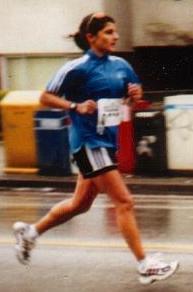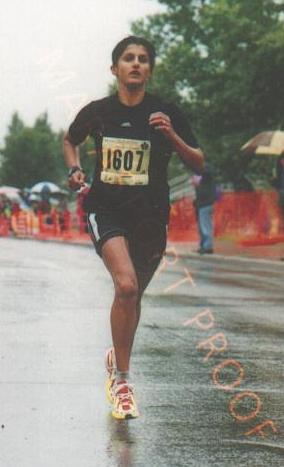Newsletter

enhancing female performance

enhancing female performance
Vol 1. Issue 2
September 1999
Advance Article:
Training consists of stressing a particular physiological system followed by rest to allow it to re-build itself stronger than before. Both components of training are important. Often we ignore the rest portion and focus mainly on the stressing..
To become a (complete) runner, requires concentrating on four major training components:
VO2max,
Anaerobic Threshold,
Aerobic Endurance,
Running Efficiency.
VO2max
This refers to the maximum volume of oxygen per kilogram of weight that a person requires in converting fuel to energy. As there is a direct correlation between oxygen usage and energy consumed, this represents the upper limit of energy available to an exercising muscle. This upper limit is largely determined by genetics, however training may increase it 20%. To achieve the upper limit, you will need to run fast.
Interval training is one method runners have used to improve their V02max. After warming up for ten minutes, you can perform intervals ranging from 2 to 8 minute durations. Running longer than this will mean you won't be running close to your VO2max, thus you won't stress your system.
After running near your upper limit for some time, your body will make adaptations and try and increase it.
Anaerobic Threshold
This is when the oxygen a muscle requires is no longer completely provided by the air that you breathe. Here your muscles switch from aerobic (with oxygen) to anaerobic (without oxygen) operation. Lactic acid begins to build up. You go into oxygen debt and if this cannot be corrected you stop producing energy and you stop running ! Pain is usually felt.
The switch over point is normally expressed as a percentage of your VO2max. The goal is to increase your anaerobic percentage. It usually varies from about 50-60% of VO2max for untrained runners to 90% of VO2max for elite runners. This is the speed that most long distance racing is done at. The key is to balance performance against lactic build up.
Training this system involves running right at this cross-over point. Most often this type of training is referred to as a time trial or tempo run. This type of training involves race pace running for between 20 and 40 minutes. A warmup and a cool down is required.
Aerobic Endurance
This refers to how well we utilise the fuel sources in our body for running. Generally, there are two main sources of fuel. The most efficient is glycogen (sugar) and the longest lasting is fat. We try and teach our bodies to conserve as much glycogen as possible while trying to become more efficient at using fat for fuel. Running fast uses almost exclusively glycogen as fuel while running longer than an hour must utilise fat.
Hitting the wall in a marathon usually occurs when our glycogen stores are depleted. In extreme cases, as our brains use glycogen for fuel, we can collapse and/or act confused. It pays to become better at using fat and learning how to conserve glycogen as much as possible. This factor is trained by running for long periods of time (+ hour).
There is an optimum speed to stress the system but the basic thing is to run for a long time.
Running Efficiency
Every runner wants to be able to run with an efficient form.
You want to minimize the muscle activity needed for movement and mimimize the oxygen needed for forward motion. All muscle activity should be focused on moving forward, not side to side or up and down. Keep the height of your feet above the ground only enough to move them forward. Keep rear kicks simple. Develop an optimum stride length and frequency (leg turnover rate). Relax your upper body. Use your hands and arms to help you maintain an even stride. Avoid bouncing from side to side. Think about your running posture and focus on correcting one thing at a time.
Practice doesn't make perfect, perfect practice makes perfect.
-Fariyal Samson, B.PE, B.Ed
© Women in Motion September 1999.

-from an adidas poster
The Running Woman Message Board in FB
Apparently there are some changes in the works for the 'Fitness and Beauty' site. Fitness and Diet looks like the new focus. This I believe will be a better match. Some of you may have noticed a board in BH called 'Running'. It presently is unhosted and may become incorporated with us. Having two boards dealing with the same topic is redundant. Ours is the more active message board.
The past month has again been enjoyable and I look forward to continue making contacts with new members and renewing old contacts. A reminder that experts, we are not. As I pointed out to a member, in our own running group here at home, it is difficult to get agreement on most anything. If it works for you, then it works.
Gord
About This Newsletter
You are receiving access to this newsletter because you emailed winmotion or cl-winmotion with a running request. If you do not wish to have future newletters sent to you, please send an email to: winmotion@ivillage.com using the word "unsubscribe" in the title.
If you have any suggestions for topics or questions please email us. We would like to create a monthly newsletter that reflects the interests of the female runner.
Gordon Samson, Editor
Women in Motion
LEGAL STUFF / SUBSCRIPTION INFO.
"Women in Motion Newsletter" is free, but its contents
are copyrighted.
Nobody may use the content without permission of the
author and "Women in Motion."
Finally an interesting short tip from the 'Runner's World"
Don't count on diet soda for weight loss:
Researchers from the United Kingdom offered either water, a sugary beverage or a beverage with the artificial sweetener aspartame to people who had just exercised for 50 minutes. Then, researchers let everyone eat. Those who drank the artificially sweetened drink ate more than those who drank water or the higher-calorie beverage.
